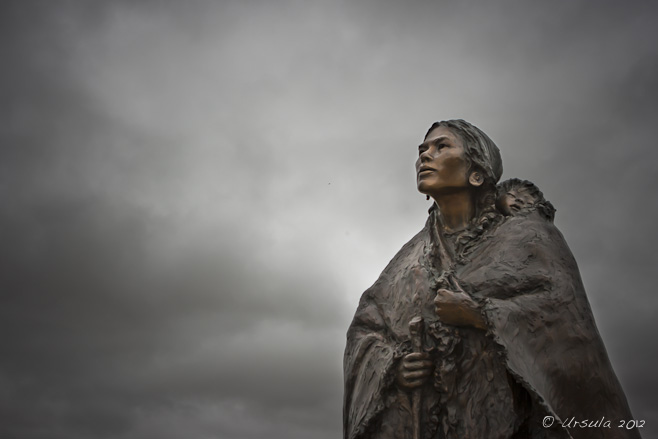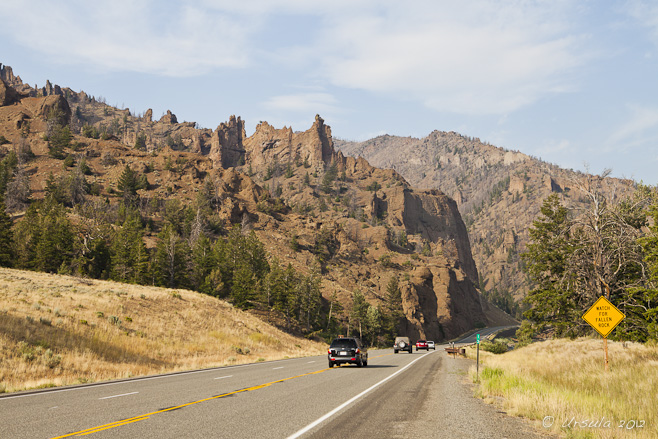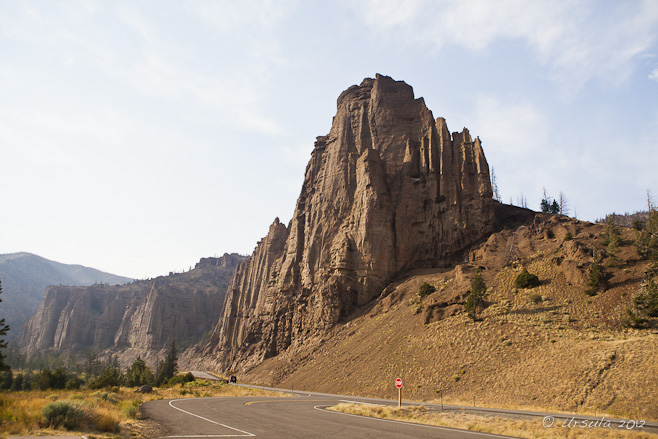
Sacagawea and Baby Jean Baptist
Sculpture by Glenna Goodacre (b. 1931), Buffalo Bill Historical Center, Cody, WY
The Wild West is a place of legends and stories…
Few are more moving than that of Sacagawea (Bird Woman), the Lemhi Shoshone woman, kidnapped in 1800 by a raiding party of Hidatsa when she was about 12, and a year later, given or sold, along with another young captive Shoshone girl, to Toussaint Charbonneau, a French Canadian trapper. Thirty-four year old Charbonneau was hardly a prime catch: six years earlier he had been stabbed by an old Saultier woman for raping her daughter.
In 1804, Lewis and Clark hired Charbonneau as an interpreter for their expedition to explore the Western United States, because Shoshone-speaking Sacagawea was part of the deal. She gave birth to her first child, Jean Baptist, February 11, 1805, before the expedition set off, and the child travelled with her across the country. “Meriwether Lewis called [Charbonneau] “a man of no peculiar merit”.” Sacagawea, on the other hand, so impressed Lewis and Clark when she rescued their journals, records and other materials from the Missouri River after a boat capsized, that they named the Sacagawea River in her honour.
In American popular history, Sacagawea is an integral part of the Lewis and Clark story: in the early twentieth century, the National American Woman Suffrage Association adopted her as a symbol of women’s worth and independence; in 2000, the United States Mint issued the Sacagawea dollar coin in her honour; and in 2001, then-president Bill Clinton gave her the title of Honorary Sergeant, Regular Army.
I suppose if I were an American, I’d have know more about Sacagawea before visiting Wyoming – in the Wild West, the place of legends and stories…

Watch for Fallen Rock
The road out of Yellowstone National Park and into the rest of Wyoming lead us through a magnificent rocky landscape.

Like a scene out of a Western movie, rocky outcrops overwhelm the road. We have arrived in frontier country.
We found a motel in Cody, Wyoming, and parked our little sedan next to the Harley Davidson motorcycles and Mack trucks in the car park. Taking the desk clerk’s advice on eateries, we headed down the road to Cassie’s Roadhouse, a typically western-looking bar with a cowboy on a bucking bronco in neon over the front door… and a huge parrot on the sign over the drive-in entry.
Here we learned about another woman who managed to succeed against the odds. Cassie Welsh moved to Cody with her father and married a local engineer in 1907. He died shortly thereafter, so she opened a “Ladies of the Night” house in central Cody. She later moved to the current Roadhouse on the West Strip, where she owned and ran the genteely-named Cassie’s Supper Club until her death in 1952. She is fondly remembered locally as “a lovely lady who always helped people”.
The parrot became a trademark of the next owners, who had brought two live birds from Brazil – as one does.
The restaurant was full when we arrived, and rather than wait we decided to sit in the bar, next to the wooden dance floor where two couples were about to practice. I thought we might be up for some line-dancing or a country two-step, but no! On Tuesdays, the local dance champion and instructor gives free lessons; next thing we knew, we were brushing up our cha cha. In Wild West Cody!
It was far too much fun, and we never made it to the city’s nightly rodeo.
The next morning, we allocated some time to visit the Buffalo Bill Historical Center.
Not enough time, as it turns out. It is for good reason that the entry ticket is valid for two days: the complex of five museums in one building has been described by The New York Times as “among the nation’s most remarkable museums.” (Edward Rothstein, New York Times, August 3, 2012).

Grizzly Bear
We entered the Buffalo Bill Historical Center through the Draper Museum of Natural History which depicts various aspects of the Greater Yellowstone area. We found it fascinating after having just been in the National Park itself.
Enter the ultimate Wild West legend: Buffalo Bill Cody, a name synonymous with the history of the American West.
He was born William Frederick Cody in 1846, of Quaker parents. From 1853, his family lived in Kansas, where they were regularly persecuted for their outspoken anti-slavery stance. When Cody was 11, he became the main breadwinner after his father died of complications from injuries inflicted by a pro-slavery supporter. He worked, first as a “boy extra” – a message runner – for a freight carrier, then as a scout during the Utah War, where he gained his reputation as a an “Indian fighter”.
Cody’s colourful career is a mix of fact and “spin”. He earned his “Buffalo Bill” nickname by killing 4,280 American Bison in only 18 months (1867–1868) while he was contracted to the Kansas Pacific Railroad to supply them with meat for their workers. Not long after, Ned Buntline’s serialised stories and dime-novels turned a loosely fictionalised version of “Buffalo Bill” into a national folk hero.
By age 26, Cody had been awarded a Medal of Honor for “gallantry in action” while serving as a civilian scout. The same year, he made his stage debut in The Scouts of the Prairie, one of Buntline’s original Wild West shows. During the 1873–1874 season, “Wild Bill” Hickok joined Cody and “Texas” Omohundro in a new play called Scouts of the Plains.
Ten years later Cody founded his own “Buffalo Bill’s Wild West” show, which was staged, in one form or another, across the US and in Europe until 1908. Looking through the exhibits and memorabilia, I was amazed at the breadth and depth of performers he engaged. Fancy riders from all over the world; Western figures whose names I recognised, like Calamity Jane and Annie Oakley; Native Americans like Sitting Bull. Buffalo Bill’s troupe was successful at popularising “The West” in the US and Europe, making his persona an American icon and an international celebrity.
Like other figures who are larger than life, Cody’s legacy is a mixed one. Although responsible for thousands of buffalo deaths, he actively supported conservation, spoke out against hide-hunting, and pushed for a regulated hunting season. He was known as an “Indian fighter” but he respected Native Americans and their rights. He is quoted as saying: “Every Indian outbreak that I have ever known has resulted from broken promises and broken treaties by the government.” He was castigated as a drunkard, a fraud, a bad businessman and a racist. But while he made and lost fortunes, he was generous to a fault. He supported women’s rights and payed them, and the Native Americans and foreign nationals in his traveling show, according to merit, not race or gender.
He died in 1917, a Western legend – but almost broke.
The city of Cody, and it’s wonderful museum, is only a small part of his contribution to the American West.

Scout’s Gear
Long hair, to protect the eyes and ears; long coat for warmth; and long rifles for more accurate, powerful shots at enemy or game.

Hon. W.F. Cody Uniform and Saddle

“The Buffalo Bill Combination”
Western showmanship: Props from one of Buffalo Bill’s shows.

Annie Oakley’s Gloves
Costume from one of “Buffalo Bill’s Wild West” shows.

Luxury Tenting
View inside an American Army Scout’s base-camp tent, Buffalo Bill Historical Center.

Portable Tent
Smaller tents were used for scouting forays.
Cody called Native Americans: “the former foe, present friend, the American”.
The Plains Indian Museum section of the Buffalo Bill Historical Center depicts the history and culture of Native Americans, while highlighting their place in modern America.

Dog Soldier Feather Bonnet
Visitors examine the exhibits in the Plains Indian Museum section of the Buffalo Bill Historical Center.

Plains Indian Tent

Ancient “New World” Corns

Beaded Papoose Carriers

Woman’s Work
A Plains woman on horseback, with a travois.

Cowrie-Shell Embellished Dress
Quill working, hide painting and bead working demonstrated women’s skills, and their pride and love for their families.

Man’s Cape

Fury ~ Man and Horse

Buffalo Bill
The sculpture of a very dapper Bill Cody outside the Buffalo Bill Historical Center bids us good-bye.

Wolf Howling
Another enduring symbol of the American West…
Reluctantly, after a great lunch in the cafeteria, we set off, out of the Buffalo Bill Historical Center, out of Cody, and east – out of Wyoming…

Wyoming Prairies and Mesa

Highway I-14 East

Shell Creek
The low point, before the rise into the Bighorn Mountains.

Into a Snow Cloud
The road through the Bighorn Mountains disappears… Middle of summer, but they say it’s going to snow tonight!
 We stopped at a forlorn off-season mountain resort before descending the other side of the Bighorn Mountains. When we finally managed to attract some service, our waitress rued the “miserable climate” and the likelihood of summer snow. She was fed-up, homesick and California dreaming…
We stopped at a forlorn off-season mountain resort before descending the other side of the Bighorn Mountains. When we finally managed to attract some service, our waitress rued the “miserable climate” and the likelihood of summer snow. She was fed-up, homesick and California dreaming…
The Wild West is not for everyone.
‘Till next time!
Pictures: 15August2012



























.png)


What a great post, took me back to my child hood, so many names I recognised and knew a little about. Sounds like a place you could have easily allowed 2-3days to explore.
“Biographies” are so much more fun than “history”! 😀